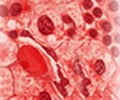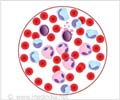A new compound present in eye drops which targets an essential cancer gene, could kill leukemia cells without harming non-leukemic blood cells.

TOP INSIGHT
A compound being developed to treat a form of eye disease also kills leukemia cells.
Mainstream AML treatments have remained unchanged for over thirty years, with the current treatment being chemotherapy, and the majority of people's cancer cannot be cured. A subtype of AML, driven by rearrangements in the MLL gene has a particularly bad prognosis.
In a previous study, researchers at the Sanger Institute developed an approach, based on CRISPR gene editing technology, which helped them identify more than 400 genes as possible therapeutic targets for different subtypes of AML. One of the genes, SRPK1, was found to be essential for the growth of MLL-rearranged AML. SRPK1 is involved in a process called RNA splicing, which prepares RNA for translation into proteins, the molecules that conduct the majority of normal cellular processes, including growth and proliferation.
In a new study, Sanger Institute researchers and their collaborators set out to work out how inhibition of SRPK1 can kill AML cells and whether it has therapeutic potential in this disease. They first showed that genetic disruption of SRPK1 stopped the growth of MLL-rearranged AML cells and then went on to study the compound SPHINX31, an inhibitor of SRPK1, which was being used to develop an eye drop treatment for retinal neovascular disease - the growth of new blood vessels on the retinal surface that bleed spontaneously and cause vision loss.
The team found that the compound strongly inhibited the growth of several MLL-rearranged AML cell lines, but did not inhibit the growth of normal blood stem cells. They then transplanted patient-derived human AML cells into immunocompromised mice and treated them with the compound. Strikingly, the growth of AML cells was strongly inhibited and the mice did not show any noticeable side effects.
SRPK1 controls the splicing* of RNA in the production of new proteins. An example of a gene that is affected when SRPK1 is blocked is BRD4, a well-known gene that maintains AML. Inhibiting SRPK1 causes the main form of BRD4 to switch to another form, a change that is detrimental to AML growth.
Professor David Bates, from the University of Nottingham and co-founder of biotech company Exonate, which develops eye drops for retinal diseases, said: "When Dr Vassiliou told me that SRPK1 was required for the survival of a form of AML, I immediately wanted to work with him to find out if our inhibitors could actually stop the leukaemia cells growing. The fact that the compound worked so effectively bodes well for its potential development as a new therapy for leukaemia. It will take some time, but there is real promise for a new treatment on the horizon for patients with this aggressive cancer."
Source-Eurekalert
 MEDINDIA
MEDINDIA
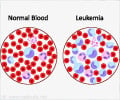

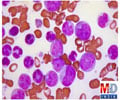
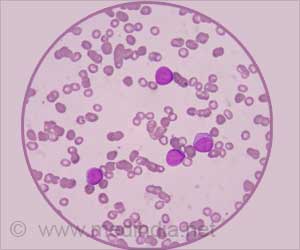
 Email
Email

